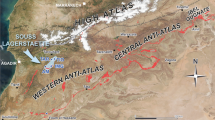Abstract
IT is common knowledge that the Suffolk Bone Bed beneath the Red Crag is made up largely of the remains of a land surface which existed, for a prolonged period, prior to the submergence of East Anglia beneath the sea of Crag times. Sir Ray Lankester pointed out many years ago1 that the bones and teeth of land mammals found in the Suffolk Bone Bed are of different ages—some being of a Miocene antiquity, while others are to be referred to certain phases of the Pliocene epoch. He was able also to show that the tooth of a mastodon, by reason of its being partly embedded in a deposit of Diestian sandstone, must be older than this Lower Pliocene accumulation, which is represented in the Suffolk Bone Bed by the well-known fossiliferous box-stones. Thus, by these investigations, it was made clear that, so far as the remains of terrestrial mammals are concerned, the contents of the Suffolk Bone Bed are markedly derivative and referable to widely separated periods anterior to the deposition of the Red Crag.
This is a preview of subscription content, access via your institution
Access options
Subscribe to this journal
Receive 51 print issues and online access
$199.00 per year
only $3.90 per issue
Buy this article
- Purchase on Springer Link
- Instant access to full article PDF
Prices may be subject to local taxes which are calculated during checkout
Similar content being viewed by others
References
Phil. Trans., B, 1912.
Proc. Prehist. Soc. East Anglia, vol. 1, pt. 1, pp. 17–43.
Author information
Authors and Affiliations
Rights and permissions
About this article
Cite this article
MOIR, J. The Pre-Crag Men of East Anglia. Nature 133, 64–65 (1934). https://doi.org/10.1038/133064a0
Issue Date:
DOI: https://doi.org/10.1038/133064a0
This article is cited by
-
Age of Sub-Crag Implements
Nature (1934)
-
The Age of the Sub-Crag Implements
Nature (1934)
Comments
By submitting a comment you agree to abide by our Terms and Community Guidelines. If you find something abusive or that does not comply with our terms or guidelines please flag it as inappropriate.



